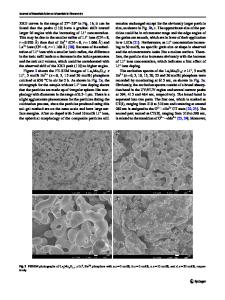Synthesis of (Y,Gd) 2 O 3 :Eu nanopowder by a novel co-precipitation processing
- PDF / 1,022,963 Bytes
- 6 Pages / 612 x 792 pts (letter) Page_size
- 67 Downloads / 314 Views
Nano-sized (Y,Gd)2O3:Eu powders were synthesized by a novel co-precipitation processing in which a mixture of ammonium hydroxide and ammonium hydrogen carbonate was adopted as a complex precipitant. Evolution behaviors of precursors during calcinations were studied by means of thermogravimetry-differential scanning calorimetry-mass spectrum, Fourier transform infrared, x-ray diffraction, scanning electron microscopy, and transmission electron microscopy in detail. Nano-sized (Y,Gd)2O3:Eu powder as prepared possessed a primary grain size of about 30 nm and specific surface area of 38 m2/g after being calcined at 850 °C for 2 h, showing much finer grains and less agglomeration. The as prepared nanopowder shows intense luminescence at 611nm under x-ray or ultraviolet excitation. Transparent (Y,Gd)2O3:Eu ceramics can also be fabricated using this high sinterable nanopowder.
I. INTRODUCTION
Europium-doped yttrium oxide (Y2O3:Eu) powder is a conventional red-emitting phosphor with very high efficiency and chemical stability under ultraviolet (UV), cathode-ray, or x-ray excitation.1 After being doped with other rare-earth (RE) ions, yttrium oxide can also serve as blue or green phosphors.1,2 Recently highperformance phosphors, particularly yttria-based were demanded with the development of high resolution cathode ray tubes (CRT), field emissive displays (FEDs), and flat panel displays (FPDs). On the other hand, transparent ceramics have received much attention because of their excellent stability, mechanical properties, and comparable transparency with single crystals. For example, highly transparent (Y,Gd)2O3:Eu ceramic and RE-doped transparent Y2O3 or Lu2O3 ceramics are good candidates for scintillators and solid-state lasers.3–5 In these applications, spherical and fine-grain particles are preferred because they provide dense packing, high luminescence, and high sinterablity. Nanocrystalline materials, typically with particle size of less than 100 nm, offer new possibility for advanced phosphors applications. Luminescence properties and spectral change of nanocrystalline cubic Y2O3:Eu powder were studied in detail.6 Because the luminescence properties of nanocrystalline Y2O3:Eu differ greatly from the bulk material, many methods were used to prepare
a)
Address all correspondence to this author. e-mail: [email protected] DOI: 10.1557/JMR.2004.0477 3586
http://journals.cambridge.org
J. Mater. Res., Vol. 19, No. 12, Dec 2004 Downloaded: 14 Mar 2015
nano-Y2O3-based phosphors, such as precipitation,7–10 sol-gel processing,11 chemical vapor deposition,6 spray pyrolysis,12 and combustion synthesis.13 Among the above-mentioned methods, the co-precipitation method is an easy and simple way to prepare multicomponent RE oxides. As mentioned above, transparent Y1.34Gd0.60Eu0.06O3 ceramics are important scintillators in X-CT,3 the codoping of Gd2O3 into Y2O3 could increase the density of the ceramics and thus increase the x-ray absorption ability, and (Y,Gd)2O3:Eu itself is an excellent phosphor. For the present paper, we pr
Data Loading...











